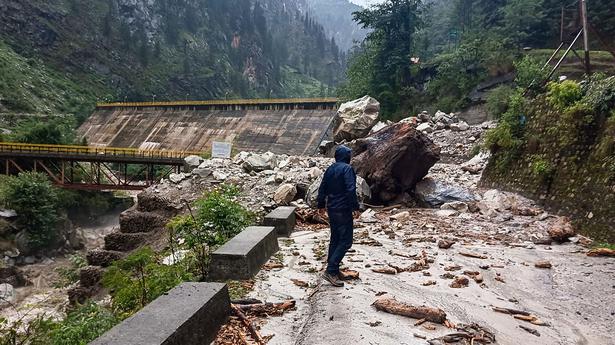
Annual trysts with nature’s fury reveal Himachal Pradesh’s reckoning with fragile ecology
The Hindu
Latest State of Environment report shows hill State is vulnerable to 25 out of 33 identified types of hazards
As Himachal Pradesh experiences the fury of nature in the form of landslides, cloud bursts, flash floods, snow avalanches and droughts year after year, natural hazards have become a matter of immediate concern, the hilly region’s latest State of Environment report shows.
The report, released by the Department of Environment, Science and Technology, points out that mountain areas are highly vulnerable to natural disasters, where development over the years has compounded the problem by upsetting the ecological balance of various physical processes. “The increased pressure on the mountain environment has contributed in some measure to environmental problems such as landslides, land subsidence, removal of vegetation and soil erosion. According to one estimate, about 58.36% of the land is subjected to intense soil erosion, the majority of which is located in the Himalayas and Himachal Pradesh, which forms part of the Western Himalayas, is environmentally fragile and ecologically vulnerable,” the report says.
It adds, “The fragile ecology of the mountain State [Himachal Pradesh] coupled with large variations in physio-climatic conditions has rendered it vulnerable to the vagaries of nature. The incidence of cloudbursts in the last few years has been unprecedented. Notwithstanding, the continuous efforts made by the Government to cope with natural hazards through relief and rehabilitation measures, landslides and snow avalanches continue to inflict widespread harm and damage to human life as well as property. The roads that are the State’s lifeline are repeatedly damaged, blocked or washed away by one or other acts of nature. In the circumstances, the Government has to divert the already scarce resources of the state for relief and rehabilitation measures.”
Read | The rumbling hills of Himachal Pradesh
Himachal Pradesh is vulnerable to 25 out of 33 types of hazards identified by the Government of India. Moreover, the State is also confronting the emerging threats of climate change, and man and animal conflict.
The report asserts that an attempt was made to develop a vulnerability matrix for the State as a whole. The overall vulnerability of the State on the basis of the matrix clearly suggests that the districts of Chamba, Kinnaur and Kullu, and parts of Kangra and Shimla, fall in the “very high” vulnerable risk status. Similarly, the districts of Kangra, Mandi, Una, Shimla, and Lahaul and Spiti, fall in “high” vulnerable risk status. The districts of Hamirpur, Bilaspur, Solan and Sirmour fall in the “moderate” vulnerable risk status.
The report says qualitative weightage was given on a scale of 0-5 for different hazards such as earthquakes, landslides, avalanches, industrial hazards, construction type, and density of population. A district-wise matrix was prepared by evaluating the risk severity. The evaluation also gave weightage to the density of the population likely to be affected. The matrix includes the evaluation of hazards likely to be induced on account of developmental works such as hydel projects, roads, and industries.











